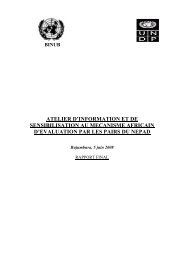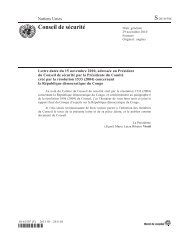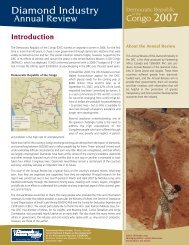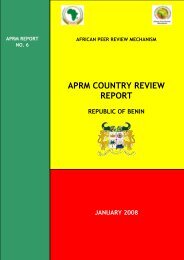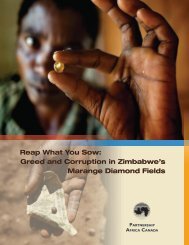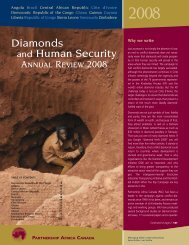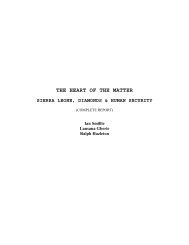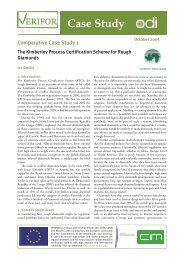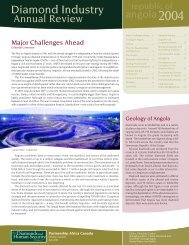sive use in Brazil and Guyana) and advising on techniques to maximizeyield and minimize environmental damage. As Endiama’s knowledge ofthe garimpeiro sector increased, Endiama MPP could eventually even takeon the role of patrocinador, advancing capital to licensed garimpeiros inreturn for a share in the profits. Working with garimpeiros in this way,Endiama could bring a significant number of garimpeiros into the formallicensed sector.However, while these proposals, in conjunction with the continuedspread of formal mining concessions, hold out the hope for a reductionin the informal sector, CIPRED committee members and <strong>Angola</strong>n authoritiesshould accustom themselves to the idea that large numbers ofunregistered garimpeiros will continue to dig without permission onunregistered sites for years to come. <strong>Angola</strong>n authorities must developthe capacity to track where these stones are coming from.As a matter of some urgency, the CIPRED committee, as well as officialsfrom Sodiam and the two informal sector buying agencies, Ascorp andLKI, need to begin considering ways to bring the Kimberley Process controlsfor the informal sector up to international standardsAt a minimum, all purchases in the field, by all levels of buyers, should berecorded on standardized forms. These forms should be collated, and thedata they contain transmitted at regular intervals, either in hard copy andelectronic format, or preferably both, to a diamond statistics office inLuanda (within Sodiam, Endiama or the Ministry). In this way, Kimberleyauthorities will have a paper trail showing the movement of diamondsfrom point of first purchase to export.As the logical next step, <strong>Angola</strong>n authorities should then look into computerizingthis information in a specialized database. Brazil, Guyana, andLiberia have recently installed databases such as these for registering andtracking diamonds. With the forms and the data stored in Luanda,<strong>Angola</strong>n authorities can begin to track the purchases and sales of individualtraders, and develop a statistical profile of where the country’sgarimpeiro diamonds are coming from.<strong>Diamond</strong>s and<strong>Development</strong>Government RevenueThe diamond tax system in <strong>Angola</strong> consists of a combination of tax levies,royalties, and export duties, and corporate taxes. Many of these are setout in 1996 decree (Decree No 4- B/96 of 31 May) which sets the corporateincome tax rate for the mining sector at 40% (reduced in 1999 to35%), while giving generous write-offs for prospecting costs 25 and depreciationallowances for capital investment costs. 26 The decree sets royaltiesfor diamonds and other precious stones at 5%, and stipulates that dividendspaid by mining companies are subject to a capital gains tax, set in1999 at 10%.As the value of <strong>Angola</strong>’s formal diamond production has increased overthe past half-decade – from just under US$690 million in 2002 to justover US$1 billion in 2005 – the revenue accruing to the <strong>Angola</strong>n governmenthas increased as well, from US$45 million in 2002 to US$150 millionin 2005.In percentage terms, government receipts in 2005 represent just under14% of the total gross production. These figures do not include the 1.2%fee paid to Sodiam, or the profits paid to Endiama for its participation injoint ventures projects. A 2005 paper by the IMF suggested that theserevenues, as a percentage of production, were low in comparison toother African diamond producers such as Botswana. Even so, at US$150million per annum, diamonds are second only to oil in terms of naturalresource revenue contributions to the <strong>Angola</strong>n exchequer.To put this value in perspective, <strong>Angola</strong>n receipts in 2005 from the diamondsector were three times as much as was allocated under the 2005budget to all government spending in either Lunda Sul or Lunda Norte,the provinces from which the diamonds originated.Source: Endiama16
Republicof<strong>Angola</strong> <strong>2007</strong>Previous Annual Reviews suggested that a fixed percentage of the tax revenuefrom diamonds (i.e. 10%) was to be channelled back into the budgetof the producing province. However, according to the Governor ofLunda Norte, Gomes Maiato, that program has now been discontinued.In the 2006 budget, the government allocated less to Lunda Norte thanto any other <strong>Angola</strong>n province. Lunda Sul, at third to last, fared onlyslightly better.EmploymentIn addition to tax revenue, the other significant contribution of the revitalizeddiamond industry has been in jobs. In 2002, there were some5,600 people employed in diamond mining joint ventures. By 2005, thishad nearly doubled, to 10,220 diamond project workers.This growth in numbers has been accompanied by an aggressive policy of<strong>Angola</strong>nization. <strong>Diamond</strong> companies are required by their contracts toseek out qualified <strong>Angola</strong>ns for all openings. Where <strong>Angola</strong>ns do not yethave the skills, joint ventures are encouraged to implement training programs,or guarantee jobs for <strong>Angola</strong>ns who return to university toupgrade their skills.The results of this policy are best illustrated by <strong>Angola</strong>’s largest project,Catoca. In 2005 Catoca employed 3300 people, 3000 of them <strong>Angola</strong>ns.<strong>Angola</strong>ns occupy the bulk of the lower level skilled trade positions, butthey are also well represented at the technical and management levels:48% (101 of 209) of college level positions are held by <strong>Angola</strong>ns, as areten of the nineteen management positions.Salaries at Catoca are considered good by <strong>Angola</strong>n standards, thoughthey are low by international standards. Overall workers salaries fallbetween US$350 and US$1500 per month. Service personnel make lessthan US$500/month. An ore truck driver earns from US$700 toUS$1000. An operator of one of the large excavators earns fromUS$1000-US$1500. Managers and engineers obviously earn a higher payscale. In total, Catoca spent US$58 million on wages and salaries in 2005,for an average salary of close to US$1500 per month.Like many of the projects, Catoca points to its high percentage of ‘localhires’ as proof of its commitment to residents of Lunda Sul. In fact, this issome accounting slight of hand in this. Local hire means that the employeewas interviewed and his contract signed and finalized locally inSaurimo. It does not mean local resident. Knowing that Catoca hires inSaurimo, many prospective workers from Luanda fly to Lunda Sul to applyfor work. Data on the number of Tchokwe speakers (the language spokenin the Lundas) would be a better test of the percentage of Lunda residentsin Catoca’s employ. However, the company says it does not collectdata on language for fear of fostering tribalism.That said, all but the most basic jobs at Catoca, as at other mines, aretechnical enough to require at least a high school education. This putsthem beyond the reach of the vast majority of the simple villagers livingin the Lundas.Corporate ContributionsThe only really visible development impact in the Lundas comes not fromgovernment or NGOs, but from the small amount of charitable work carriedout by the diamond projects themselves. Though not required bytheir contracts, many of the projects do limited development work in theimmediate vicinity of their mining sites, building schools or water supplysystems.The leader in this has been the Catoca project. The large Kimberlite minehas built a pair of six-room primary schools in nearby villages, and anotherschool combining primary and middle grades. Catoca provides teachingsupplies to the schools, and supplements the teachers’ very basic governmentsalaries with a food allowance. Catoca operates a soy milk distributioncentre, which daily donates 1500 litres of soy milk to 4000 children inthe vicinity (and generates many photos of happy children drinking frommilk containers prominently bearing the Catoca logo). Finally, Catoca hasbuilt a half-dozen small water distribution systems (essentially smallpipelines from a river to a public fountain) in villages surrounding the mine.Smaller diamond projects are proportionally less generous, in partbecause they lack Catoca’s revenue stream, but more because as alluvialprojects they have a shorter time horizon. The Catoca mine will be inoperation for decades to come, and so needs to establish good relationswith its neighbours. With a usual lifespan of less than ten years, alluvialprojects are less dependent on local goodwill.Catoca, like the other mining projects, has shown itself better at the‘hardware’ side of development work – building schools, installing pipingand faucets – than at the ‘software’ side of consulting with villagers andworking towards the social conditions needed for long term sustainability.In the village of Cachita, for example, Catoca installed a public fountain,fed from a nearby river by a two kilometre system of piping. The systembuilt in 2003, worked for a year and then broke down. No one in thevillage had been trained to fix or maintain the system, so it has remainedbroken ever since. The villagers complain that Catoca has abandonedthem at the mine, while Catoca managers wonder why the villagershaven’t fixed the system for themselves.This small conflict highlights a larger public misunderstanding about therole of diamond mining companies. Locals see diamond projects such asCatoca as a branch of the <strong>Angola</strong>n government. <strong>Angola</strong>n politicians haveoften encouraged this misunderstanding, particularly at inauguration ceremoniesfor new schools and other pieces of company-built infrastructure.For their part, Catoca managers point out that Catoca pays close toUS$100 million in taxes to the <strong>Angola</strong>n government each year, and askwhy more of this development work isn’t being done by the government.Which is, in fact, a very good question.17



